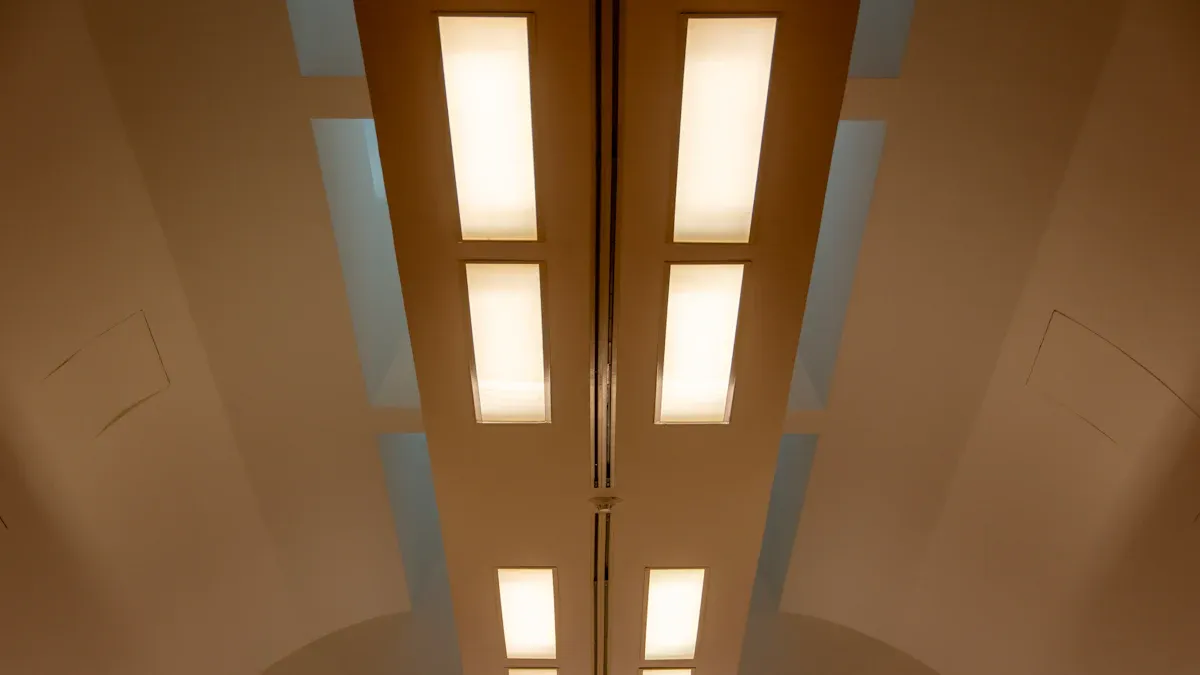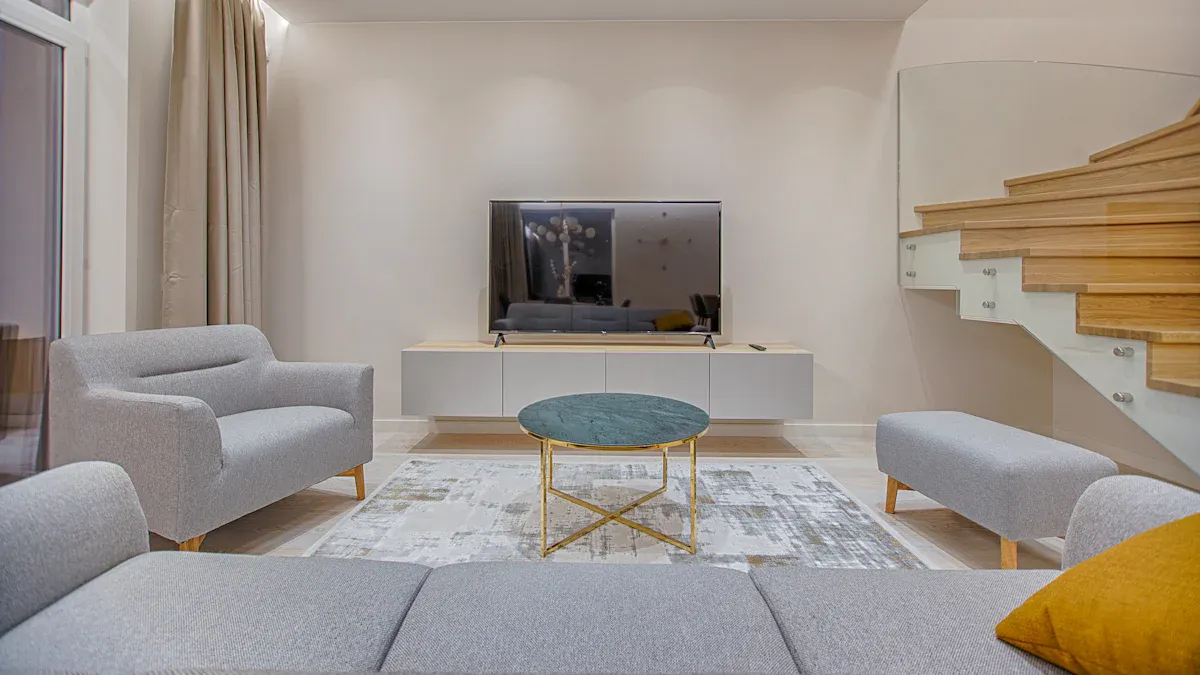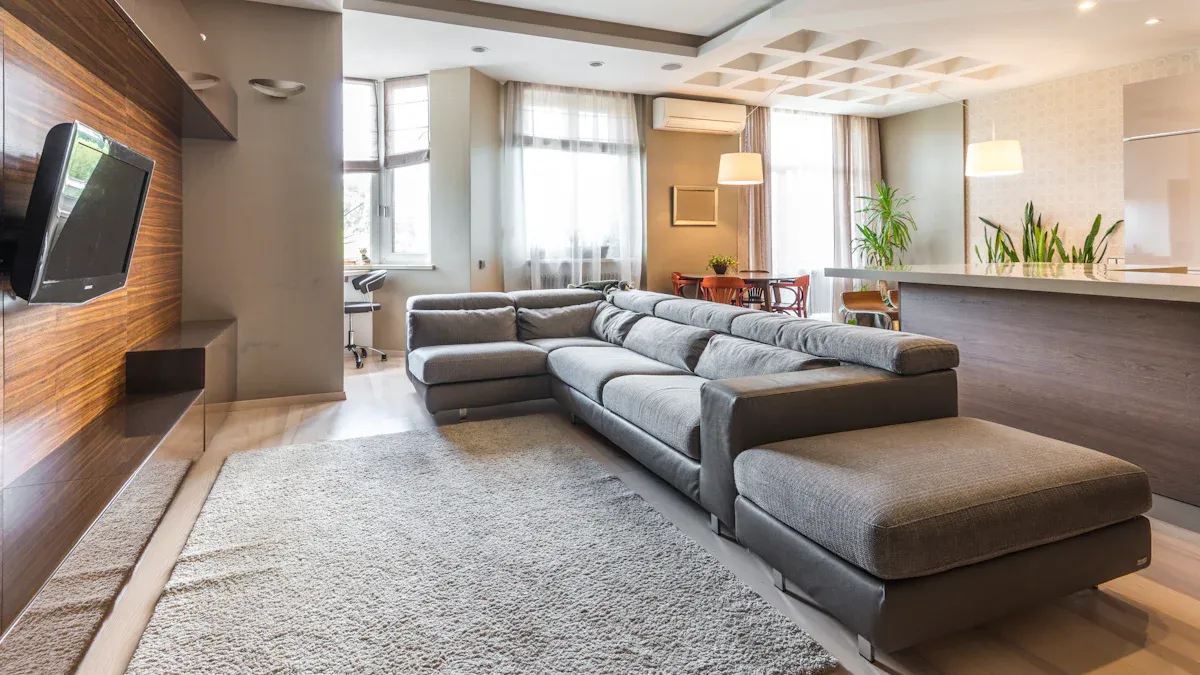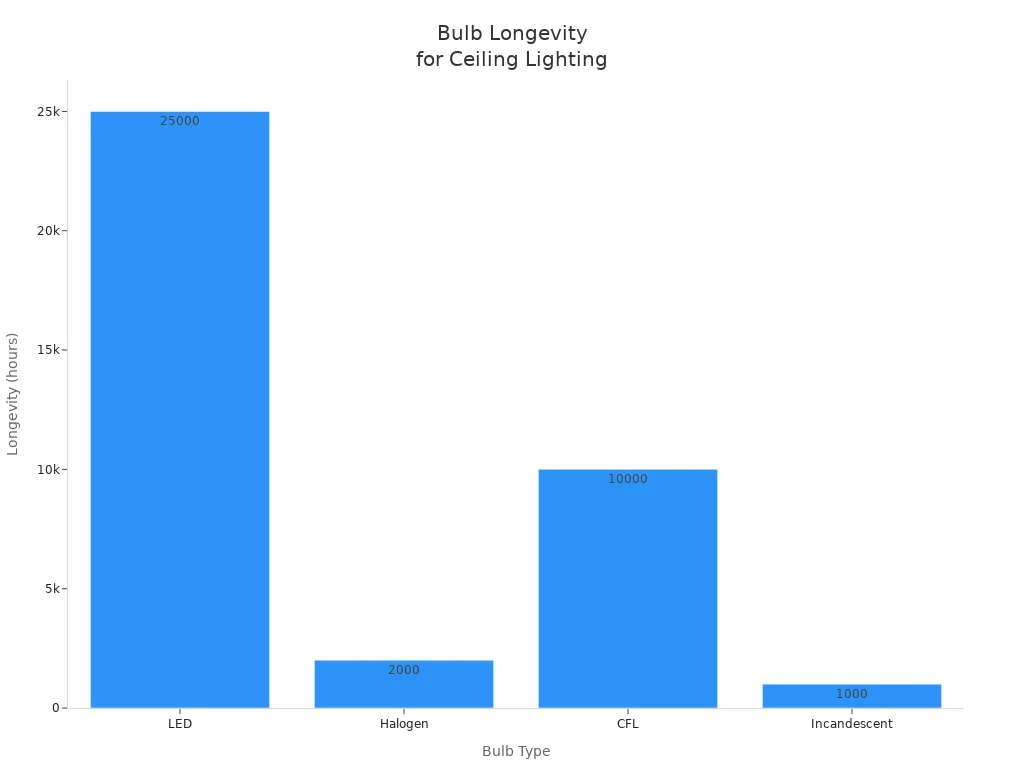Lighting Solutions for Recessed Ceilings That Highlight Your Home’s Best Features

Lighting Solutions for recessed ceilings can completely change how you see your home. You can use modern Led Light fixtures to save energy, reduce heat, and create a sleek look that blends with your style. Many Product options let you control brightness and color, so you can highlight special spaces or features. Think about which areas in your home you want to stand out. For more information, check our About Us page.
Key Takeaways
Recessed ceiling lights save space. They make rooms look clean and modern. These lights help rooms feel bigger and less crowded.
Use adjustable trims and space lights well. This helps show off things like artwork, moldings, and textures in your home.
Pick LED bulbs because they last long and save energy. They also give better light. Use dimmers and smart controls to set the mood and save energy.
Put lights in the right spots to stop glare and shadows. Use baffle trims and space lights 4 to 6 feet apart. Place wall washers 2 to 3 feet from walls.
Mix recessed lighting with other lights like sconces or lamps. This adds depth, comfort, and style to your rooms.
Recessed Ceiling Benefits

Space Optimization
You can make the most of your space with recessed ceilings. These ceilings let you install lights flush with the surface, so you do not lose any headroom. This works well in small rooms or open-plan homes. When you use recessed lights, you keep your floors and walls clear. This helps your rooms feel bigger and less crowded.
Recessed lights do not stick out, so you avoid clutter.
You can use canless LED lights in low ceilings to save even more space.
Placing lights 2 to 3 feet from walls helps prevent harsh shadows and keeps the room bright.
Tip: Carrying the lighting grid across open spaces, like kitchens and living rooms, creates a smooth flow and makes your home feel larger.
Seamless Design
Recessed ceilings give your home a clean and modern look. You can hide the light source inside the ceiling, which keeps the surface smooth. This style fits many types of decor, from classic to modern.
You can choose from many trim styles and finishes to match your room.
The lights blend in, so they do not take attention away from your furniture or art.
Minimalist design helps your space look open and uncluttered.
When you use Lighting Solutions with recessed ceilings, you get both beauty and function. You can also add smart controls for even more convenience.
Highlighting Features
You can use recessed ceiling lights to draw attention to special parts of your home. Wall-wash lights spread light across walls, making textures and colors stand out. You can highlight crown molding, coffered ceilings, artwork, or sculptures. Adjustable trims let you point the light where you want, adding depth and interest.
Recessed lights work well for accent lighting or general lighting.
Proper placement and spacing help you show off your home’s best features.
With the right Lighting Solutions, you can turn ordinary spaces into eye-catching highlights.
Lighting Solutions Overview
Fixture Types
There are many fixture choices for recessed ceilings. Slim LED downlights fit in small spaces and save energy. They only need about two inches of space above them. This makes them good for rooms with low ceilings. Baffle trims are popular because they have grooves that cut down on glare. These grooves also make the light softer and easier on your eyes. Gimbal trims can move, so you can point the light where you want. This is helpful for showing off art or special things in your room. If you like a modern look, open trims and pinhole trims look sleek and stylish. The table below lists some common trim types and what they do:
Type of Trim | Description and Benefits |
|---|---|
Baffle | Reduces glare, softens light, good for general use |
Gimbal | Adjustable direction, ideal for accent lighting |
Open | Bulb flush with ceiling, hides fixture interior |
Reflector | Amplifies light output with reflective interior |
Pinhole | Focuses light downward, highlights objects |
Lighting Solutions with these fixtures help your ceiling look neat and modern. They also help you use less energy.
Placement Tips
Putting recessed lights in the right spot changes how your room feels. Accent lights should be at a 30-degree angle from the ceiling. This helps stop glare and makes features stand out. For wall washing, put lights 18 to 30 inches from the wall. Gimbal or eyeball trims can be aimed where you need light. In kitchens, keep lights 24 to 30 inches from walls. This helps counters stay bright and stops shadows. Try not to put lights right over seats or TVs. This keeps glare away from your eyes. Use other lights like sconces or pendants with your recessed lights. This adds layers and makes your space more interesting.
Tip: Dimmers and smart controls let you change the brightness. You can set the mood for any activity.
Wiring and Safety
It is very important to be safe when putting in recessed ceiling lights. Always turn off the power at the breaker before you start. Use a voltage tester to check that the power is really off. Wear safety goggles and a dust mask when cutting the ceiling. Make sure the circuit can handle the new lights. Do not put fixtures too close to ceiling joists. Use good wiring and follow all local rules. If you are not sure about wiring, call a licensed electrician. Pick IC-rated fixtures if your lights will touch insulation. Make sure all wires are tight and covered. Good Lighting Solutions look nice and keep your home safe and efficient.
Feature Highlighting Techniques

Accent Lighting
Accent lighting helps you show off the best parts of your home. Recessed lights can make moldings, artwork, and alcoves stand out. Put spotlights so they shine right on your favorite paintings or photos. This makes the colors look brighter and adds excitement to the room. If you have shelves or display spaces, put recessed lights inside them. This gives a soft glow that shows off your collections without being too bright.
LED strip lighting is great for crown molding. You can hide the strips behind the molding to make a gentle line of light. Wall washers are also a good choice. They spread light across the wall, showing textures and making the room feel bigger. Accent lighting creates special spots that guide your eyes around the room.
Tip: Use accent lighting with other lights, like table lamps or sconces. This layering adds depth and makes your space feel warm and welcoming.
Spacing and Angles
Good spacing and angles make your Lighting Solutions work better. Space recessed lights about 4 to 6 feet apart. For a 10-foot ceiling, put lights about 5 feet apart. This keeps the light even and stops dark spots. To highlight a wall or feature, put the lights 2 to 3 feet from the wall. This makes a wall-washing effect that shows off textures and colors.
If you have vaulted ceilings or sloped features, move the lights closer to the wall or slope. Angle the fixtures so the light hits the feature directly. Adjustable trims, like gimbal or eyeball trims, let you point the light where you want it. Use narrow beam angles (15°-30°) for focused spots on art or moldings. Pick wider angles (50°-120°) for general lighting.
Space lights evenly, about 4-6 feet apart.
Put lights 2-3 feet from walls for wall washing.
Use adjustable trims for aiming.
Note: Layering recessed lighting with other lights, like floor lamps or pendants, helps stop shadows and makes the room look balanced.
Avoiding Glare
Glare can make a room hard to enjoy. You can lower glare by picking the right trims and placing your lights well. Baffle trims have grooves that soak up extra light. This makes the light softer and easier on your eyes. Architectural downlights use special shapes to send light away from your eyes. These features help you enjoy bright rooms without harsh reflections.
Here is a table that shows common mistakes and how to fix them:
Mistake | Effect | How to Avoid |
|---|---|---|
Glare from bright or poorly angled lights | Eye strain, discomfort | Adjust fixture angles, use baffle trims or diffusers |
Shadows from poor placement | Rooms feel smaller, hard to navigate | Layer lighting, use accent and task lights |
Unbalanced ambiance with uneven lighting | Room feels stark or poorly lit | Balance ambient, task, and accent lighting |
Direct light over beds in bedrooms | Uncomfortable, harsh ambiance | Position lights away from direct line of sight, use dimmers |
Insufficient task lighting in kitchens | Unsafe or inefficient work areas | Place lights over work surfaces, add under-cabinet strips |
When you plan your Lighting Solutions, always think about comfort and style. Use dimmers to control brightness and set the mood for any activity. If you are not sure about where to put lights or which trims to pick, ask a lighting expert for help.
Practical Tips
Bulb Choices
When you pick bulbs for recessed ceiling lights, you want the best mix of quality and savings. LED bulbs work well for most homes. They last up to 25,000 hours or more, which means you will not need to change them often. LEDs use less energy than other bulbs, so you save money on your electric bill. They also make less heat, which keeps your rooms cooler. You can find LEDs in many shapes and sizes, and most are dimmable. CFL bulbs use less energy than old incandescent bulbs, but they take time to warm up and have mercury inside. Incandescent bulbs give a warm glow but burn out quickly and use more power.
Bulb Type | Longevity (hours) | Light Quality | Other Features |
|---|---|---|---|
LED | Up to 25,000+ | Many color choices; dimmable; bright light | Energy-saving; low heat; no mercury |
Halogen | ~2,000 | Bright, warm light | Gets hot; needs careful placement |
CFL | ~10,000 | Decent light; slow to warm up | Contains mercury; needs safe disposal |
Incandescent | Shortest lifespan | Warm, natural light | Uses more energy; needs replacing |

Tip: Choose LED bulbs for your Lighting Solutions to get the best mix of long life, energy savings, and light quality.
Color Temperature
Color temperature changes how your room feels. Warm light (2700K–3000K) makes spaces feel cozy and calm. You might use this in bedrooms or living rooms. Neutral light (3500K–4500K) gives a balanced, natural look. This works well in kitchens, bathrooms, or home offices. Cool light (5000K–6500K) feels bright and crisp. It helps you focus and see details, so it fits in workspaces or study areas.
Color Temperature | Mood and Function Impact | Best Home Areas | Appearance and Feature Highlighting |
|---|---|---|---|
2700K–3000K (Warm) | Cozy, relaxing, inviting | Bedrooms, living rooms | Makes spaces feel warm and comfortable |
3500K–4500K (Neutral) | Balanced, natural, accurate | Kitchens, bathrooms, offices | Shows colors and textures clearly |
5000K–6500K (Cool) | Bright, energizing, focused | Offices, study areas | Highlights details, gives a modern look |
Note: You can layer different color temperatures in one room to create both comfort and focus.
Dimmers and Controls
Dimmers and smart controls help you get the most from your recessed ceiling lights. You can change the brightness for any activity, like reading or watching TV. Smart controls let you set schedules, use voice commands, or control lights from your phone. This saves energy because you only use the light you need. You can also change the color temperature with some smart systems, which helps set the mood for any time of day.
Control lights from anywhere with smart devices.
Use voice commands for hands-free changes.
Set schedules for daily routines or vacations.
Tip: Make sure your LED fixtures and dimmers work together. This helps avoid flickering or other problems.
Lighting Solutions with dimmers and smart controls give you more comfort, style, and savings in your home.
You can change how your home looks by planning your lighting. Think about what you do in each room. Use different types of lighting for the best effect. Mix ambient, task, and accent lighting to make layers. Place recessed lights so they are spaced out evenly. Add dimmers so you can change the brightness. Many people start with the kitchen or living room. These rooms need good lighting the most. Try updating one room first. You will see how better lighting makes your home more comfortable and fun.
FAQ
What is the best type of bulb for recessed ceiling lights?
You should choose LED bulbs. LEDs last longer, use less energy, and stay cool. They also come in many colors and brightness levels. Most LED bulbs work with dimmers, so you can control the light easily.
How do I avoid glare from recessed lights?
Pick baffle trims or use diffusers. Place lights at a 30-degree angle from the wall. This setup helps soften the light and keeps it out of your eyes.
Can I install recessed lights in any ceiling?
You can install recessed lights in most ceilings. For ceilings with insulation, use IC-rated fixtures. Always check your ceiling’s depth and wiring before starting. Ask an electrician if you feel unsure.
How far apart should I space recessed lights?
Space your lights about 4 to 6 feet apart. For wall washing, place them 2 to 3 feet from the wall. This spacing gives you even light and highlights features.
Tip: Always plan your layout before you start cutting holes. This step saves time and prevents mistakes.
See Also
Selecting Ideal Brightness And Coverage For Outdoor Flood Lighting
Wallpack Lights As The Best Choice For Commercial Exteriors
Innovative Lighting Options For Contemporary Commercial Environments

